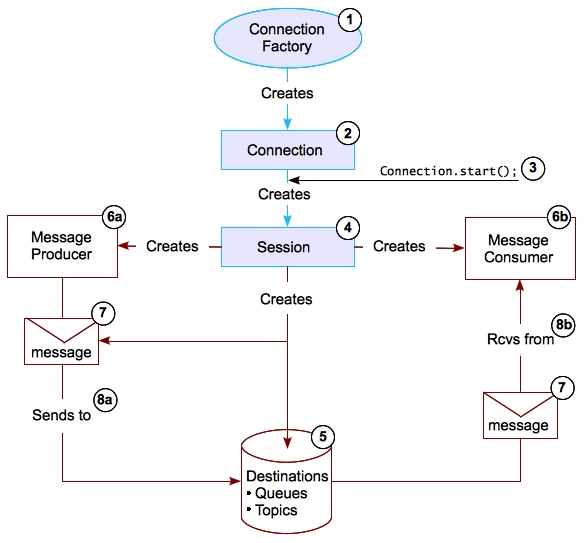此内容没有您所选择的语言版本。
2.3. JMS Development
Overview
Developing applications using the JMS APIs is a straightforward process. The APIs facilitate the creation of objects that mitigate the interface between client applications and the message broker. Once connected to a broker, clients can create, send and receive messages.
Basic application components
A JMS application typically consist of these basic interfaces and classes:
- Connection factory
- Connection factories are administered objects that clients use to create connections to a message broker. You can optimize some messaging characteristics by enabling, disabling, or otherwise modifying the values of certain connection factory properties.
- Connection
- Connections are the objects clients use to specify a transport protocol and credentials for sustained interaction with a broker.
- Session
- Sessions are created by a client on a connection established with a broker. They define whether its messages will be transacted and the acknowledgement mode when they are not. Clients can create multiple sessions on a single connection.
- Destinations
- Destinations are created by a client on a per-session basis. They are client-side representations of the queue or topic to which messages are sent. The message broker maintains its own representations of the destinations as well.
- Producer
- Producers are client-side objects that create and send messages to a broker. They are instances of the
MessageProducerinterface and are created on a per-session basis.TheMessageProducerinterface provides methods not only for sending messages, but also for setting various message headers, includingJMSDeliveryModewhich controls message persistence,JMSPrioritywhich controls message priority, andJMSExpirationwhich controls a message's lifespan. - Consumer
- Consumers are client-side objects that process messages retrieved from a broker. They are instances of the
MessageConsumerinterface and are created on a per-session basis.TheMessageConsumerinterface can consume messages synchronously by using one of theMessageConsumer.receive()methods, or asynchronously by registering aMessageListenerwith theMessageConsumer.setMessageListener()method. With aMessageListenerregistered on a destination, messages arriving at the destination invoke the consumer'sMessageListener.onMessage()method, freeing the consumer from having to repeatedly poll the destination for messages. - Messages
- Messages are the backbone of a messaging system. They are objects that contain not only the data payload, but also the required header and optional properties needed to transfer them from one client application to another. See Section 2.2, “JMS Message Basics”.
Development steps
Figure 2.2, “Messaging sequence” shows the typical sequence of events involved in sending or receiving messages in a Red Hat AMQ client application.
Figure 2.2. Messaging sequence

The following procedure shows how to implement the sequence of events shown in Figure 2.2, “Messaging sequence”:
- Get a connection factory.The process for getting a connection factory depends on your environment. It is typical to use JNDI to obtain the connection factory. AMQ allows you to instantiate connection factories directly in consumer code or obtain connection factories using Spring in addition to using JNDI.
- Create a connection from the connection factory as shown in Example 2.1, “Getting a Connection”.
Example 2.1. Getting a Connection
connection=connectionFactory.createConnection();
- Start the connection using the connection's
start()method. - Create a session from the connection.
Example 2.2. Creating a Session
session=connection.createSession(false, Session.AUTO_ACKNOWLEDGE); - Create a destination from the session.Example 2.3, “Creating a Queue” shows code for creating a queue called
foo.Example 2.3. Creating a Queue
destination=session.createQueue("FOO.QUEUE"); - Create objects for producing and consuming messages.
- Create a producer as shown in Example 2.4, “Creating a Message Producer”.
Example 2.4. Creating a Message Producer
producer=session.createProducer(destination);
- Create a consumer as shown in Example 2.5, “Creating a Consumer”.
Example 2.5. Creating a Consumer
consumer=session.createConsumer(destination);
- Create a message from the session object.Example 2.6, “Creating a Text Message” shows code for creating a text message.
Example 2.6. Creating a Text Message
message=session.createTextMessage("This is a foo test."); - Send and receive messages.
- Send messages from the producer as shown in Example 2.7, “Sending a Message”.
Example 2.7. Sending a Message
producer.send(message);
- Receive messages from the consumer.Example 2.8, “Receiving a Message” shows code for synchronously receiving a text message.
Example 2.8. Receiving a Message
message = (TextMessage)consumer.receive();
- Close all JMS resources.